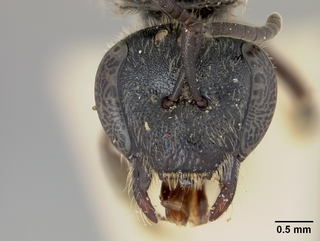
Smithsonian Institution, Entomology Department · 9
Lasioglossum cinctipes, female, face |
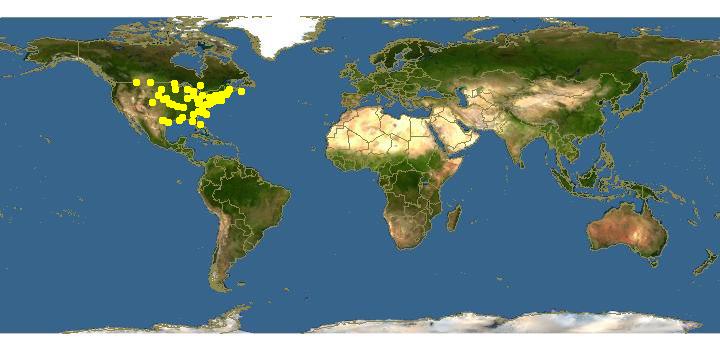
Click on map for details about points.
|
80x5 -
240x3 -
240x4 -
320x1 -
320x2 -
320x3 -
640x1 -
640x2
Set display option above.
Click on
images to enlarge. |
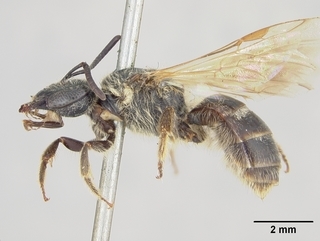
Smithsonian Institution, Entomology Department · 9
Lasioglossum cinctipes, female, side |
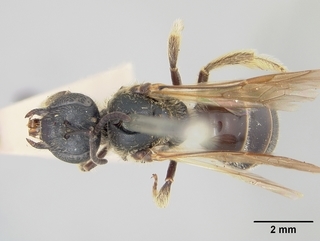
Smithsonian Institution, Entomology Department · 9
Lasioglossum cinctipes, female, top |
|
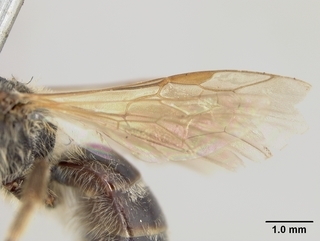
Smithsonian Institution, Entomology Department · 9
Lasioglossum cinctipes, female, wing |
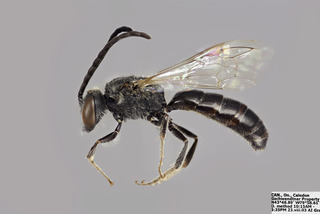
© Copyright Laurence Packer 2014
· 7
Lasioglossum cinctipes MALE CFP comp |
|
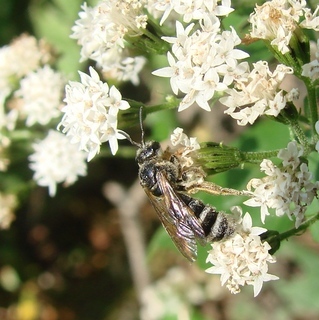
© Copyright John Ascher, 2006-2014
· 2
Lasioglossum cinctipes |
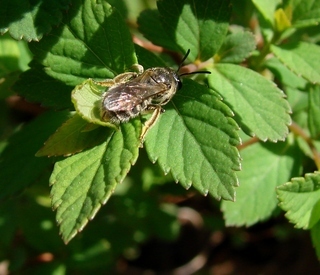
© Copyright John Ascher, 2006-2014
· 1
Lasioglossum cinctipes |
|
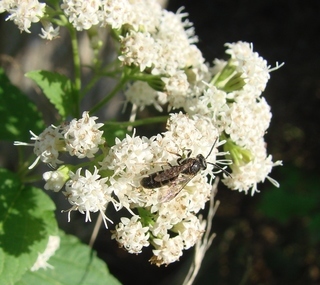
© Copyright John Ascher, 2006-2014
· 1
Lasioglossum cinctipes, sweat bee |
|
Overview |
Reprinted with permission from: Mitchell, T.B. 1960 Bees of the Eastern United States. North Carolina Agricultural Experiment Station Technical Bulletin No. 141.
FEMALE�Length 8 mm.; black; pubescence whitish, rather thin; head much broader than long; clypeus only slightly convex, projecting about one-half below suborbital line; eyes very slightly convergent below; cheeks slightly broader than eyes; lateral ocelli very slightly nearer margin of vertex than to eyes; face above antennae dull, finely rugoso-punctate, punctures below antennae well separated on supraclypeal area and upper margin of clypeus, becoming more coarse and sparse on clypeus apically, area between eyes and ocelli rather dull, punctures hardly evident; vertex dull medially, obscurely striate, cheeks somewhat shining, very minutely and obscurely punctate above, becoming finely striate below; scutum with a quite deep, median, anterior groove, rather dull, punctures quite deep and distinct, will separated over median area of disc, becoming rather close laterally and posteriorly, but much finer and more obscure anteriorly; scutellum rather dull, with a slight, more closely punctate median impression, the punctures variable and scattered on each side of this; pleura dull, rather finely and uniformly rugoso-striate; dorsal area of propodeum rugoso-striate, posterior face somewhat shining, shallowly reticulate, the lateral carinae strongly divergent, quite short; wings subhyaline, veins and stigma testaceous; tegulae reddish-testaceous, with whitish-hyaline anterior rim; legs somewhat reddened, becoming more definitely ferruginous on apical tarsal segments, hind basitibial plate rather small, triangular, subacute; abdominal terga shining, punctures very fine and indistinct, these very sparse and obscure on basal segment, rather close and more distinct on tergum 2 basally but becoming very sparse and obscure apically and on terga 3 and 4, basal white fasciae on terga 2 and 3 evident laterally, discal pubescence extremely short, thin and obscure, entirely white.
MALE�Length 8 mm.; black, clypeus apically and mandibles in part, yellow; pubescence whitish, very thin and quite short in general, but lower portion of face quite densely tomentose; head considerably broader than long; clypeus slightly convex, projecting nearly one- half below suborbital line; eyes rather strongly convergent below; mandibles dark at extreme base, yellowish medially, the elongate apex reddish; labrum dark, subtriangular; cheeks very slightly narrower than eyes; lateral ocelli very slightly nearer margin of vertex than to eyes; basal segment of flagellum, very short, barely exceeding pedicel in length, second and following segments elongate, fully twice as long as broad, piceous below, blackish above; face above antennae dull, very densely rugosopunctate, lower portion of face somewhat more shining beneath the pubescence, punctures deep and distinct but rather close on supraclypeal area, clypeus with rather fine, close and deep punctures basally, these becoming much more coarse and sparse apically, area between eyes and ocelli roughened, obscurely punctate; vertex medially rather dull, obscurely striate, the cheeks largely striate; scutum shining, punctures deep and distinct, well separated medially, becoming rather fine and close but not crowded laterally, obscure anteriorly where the surface is dull and tessellate; scutellum shining, with a rather deep, median groove, somewhat protuberant on each side of this, punctures rather fine and close but not crowded; pleura densely and rather finely rugose above, becoming smooth and somewhat shining below; dorsal area of propodeum coarsely striate, posterior face coarsely reticulate, the lateral carinae strongly divergent but rather obscure, incomplete; wings hyaline, veins and stigma testaceous; tegulae piceous, anterior rim narrowly yellowish-testaceous; legs dark, but the more basal tarsal segments bright yellow, these becoming darker apically; abdominal terga shining, quite deeply but very finely punctate, the punctures distinctly but not widely separated on basal segment, somewhat closer on the second and following segments basally, but becoming more minute and sparse apically, the basal, whitish fasciae very thin and inconspicuous, discal pubescence hardly evident; apical margin of sternum 5 straight, 6 broadly rounded; gonostylus simple, consisting only of a rather short, somewhat compressed, apical lobe which is thinly clothed with very fine, inconspicuous pubescence, no ventral, retrorse lobe evident.
DISTRIBUTION�Minnesota to Quebec and the New England states, south to North Carolina; May to September.
FLOWER RECORDS � Eupatorium, Rhus, Solidago and Viburnum.
A specimen of Halictus adelipus Vachal, probably the type, in the Paris Museum, has been examined, and seems to lie within the range of variation of cinctipes.
|
|
|
Identification | |
This is a large species, 8-9mm, much closer in size to the Lasioglossum sensu strictu than the other black species groups. In the female there can be a substantial band of appressed white hairs at the base of T2-3, taking up to one third of the segment, but commonly it is narrower and is partially covered by the preceeding tergite and thus just the white patches of hair at the sides show.
Extracted from: Gibbs, J., Packer, L., Dumesh, S. and Danforth, B. N. 2013. Revision and reclassification of Lasioglossum (Evylaeus), L. (Hemihalictus) and L. (Sphecodogastra) in eastern North America (Hymenoptera: Apoidea: Halicidae). Zootaxa 3672 (1). Pp 1-116.
Male L. cinctipes is unique among Eastern North American species in having the retrorse lobe absent (Fig.
46A). They can also be recognised by the combination of head wide (L/W ratio = 0.87–0.93) (Fig. 44A); clypeus
not protruding much below suborbital line, distal margin yellow (Fig. 44A); F2 approximately equal in length to
scape; T2 apical impressed area with numerous punctures (Fig. 86A); gonostylus short, without short hairs (Fig.
45A). Lasioglossum cinctipes is most similar to L. truncatum, but the latter species differs in the following: head
longer (L/W ratio = 0.95–1.01) (Fig. 44I); clypeus protruding well below suborbital line; T2 apical impressed area
with sparse punctures (Fig. 86B); retrorse lobe present (Fig. 46I); and gonostylus with long, plumose hairs (Fig.
45I).
Redescription. FEMALE. Length 6.2–8.3 mm. Head length 1.70–2.20 mm. Head width 1.99–2.38 mm. Wing
length 4.9–6.4 mm. (n=8)
Colour. Head and mesosoma black. Antenna black, except ventral surface of flagellum brown. Tegula dark
reddish brown. Legs dark brown, except medio- and distitarsi reddish brown. Wing membrane hyaline, faintly
dusky. Pterostigma testaceous. Metasomal terga black-brown, apical margins pale brown-testaceous.
Structure. Head very wide (L/W ratio = 0.83–0.93). Clypeus 1/2 below suborbital line. Eyes convergent below
(UOD:LOD = 1.04–1.11). Gena slightly wider than eye. Ocelli normal. Pronotum smoothly rounded, dorsolateral
angle obtuse. Protibial spur with apical serrations as long as width of malus. Inner metatibial spur serrate, teeth 3–
6, basal teeth clearly shorter than width of rachis. Propodeal lateral carina, reaching dorsolateral slope, oblique
carina indistinct from background sculpturing.
Surface sculpture. Supraclypeal area imbricate-weakly polished, punctures sparse (i=1–2.5d). Gena lineolate,
postgena smoother. Mesoscutum polished, weakly imbricate anteromedially; punctures dense laterally (i≤d), wellspaced between parapsidal lines (i=1–2d). Mesepisternum rugose, weaker ventrally. Metapostnotum coarsely
rugose. Propodeum imbricate-tessellate. Metasomal terga polished, apical impressed areas coriarious; punctures
dense, distinct basally, finer apically.
Pubescence. Head and mesosoma with sparse plumose hairs. Metafemoral scopa with dense plumose hairs.
Metasomal terga with relatively sparse, medially-interrupted apical fimbriae. T1 with sparse, erect plumose hairs.
T2–T4 with dense basal bands of tomentum, sometimes medially (or entirely on T4) obscured by preceding
segment. Metasomal sterna with plumose scopa.
MALE. Length 6.9–8.6 mm. Head length 1.68–1.99 mm. Head width 1.88–2.29 mm. Wing length 5.2–6.3
mm. (n=6)
Colour. Head and mesosoma black. Clypeus yellow on apical half, maculation size variable. Mandible brown
basally, yellow apically. Labrum brown. Antenna black, except ventral surface of flagellum brown. Legs dark
brown, except tarsi, anterior surface of protibia yellow-testaceous. Wing membrane hyaline. Pterostigma orangebrown. Metasomal terga dark brown, pale brown-testaceous apically.
Structure. Head wide (L/W ratio = 0.87–0.93). Clypeus ½ below suborbital line. Mandible short, reaching
opposing clypeal angle. Flagellomeres, except F1 elongate, F2 longer than F1 and pedicel combined, subequal to
scape. Eyes strongly convergent below (UOD:LOD = 1.37–1.44). Gena narrower than eye. Pronotum smoothly
rounded. Propodeal lateral carina reaching dorsolateral slope, contiguous with strong oblique carina.
Surface sculpture. Supraclypeal area imbricate, with sparse punctures (i=1–2d). Gena and postgena lineolate.
Mesoscutum polished, reticulate anterolaterally; punctures dense laterally (i≤d), clearly separated between
parapsidal lines (i=1–1.5d). Mesepisternum rugulose. Metapostnotum carinate-rugose. Propodeum rugose.
Metasomal terga polished, apical impressed areas faintly coriarious; punctures close throughout.
Pubescence. Head and mesosoma with sparse plumose hairs. Face below eye emargination with dense
tomentum, sparser on clypeus. Propodeum largely bare, with scattered plumose hairs. Metasomal terga nearly bare,
without apical fimbriae. T2–T4 with basolateral tomentum. Metasomal sterna nearly bare, with sparse, short,
simple and plumose hairs (1–1.5 OD).
|
|
|
Names | |
|
|
| Supported by | |
Updated: 2024-05-08 17:45:24 gmt
|